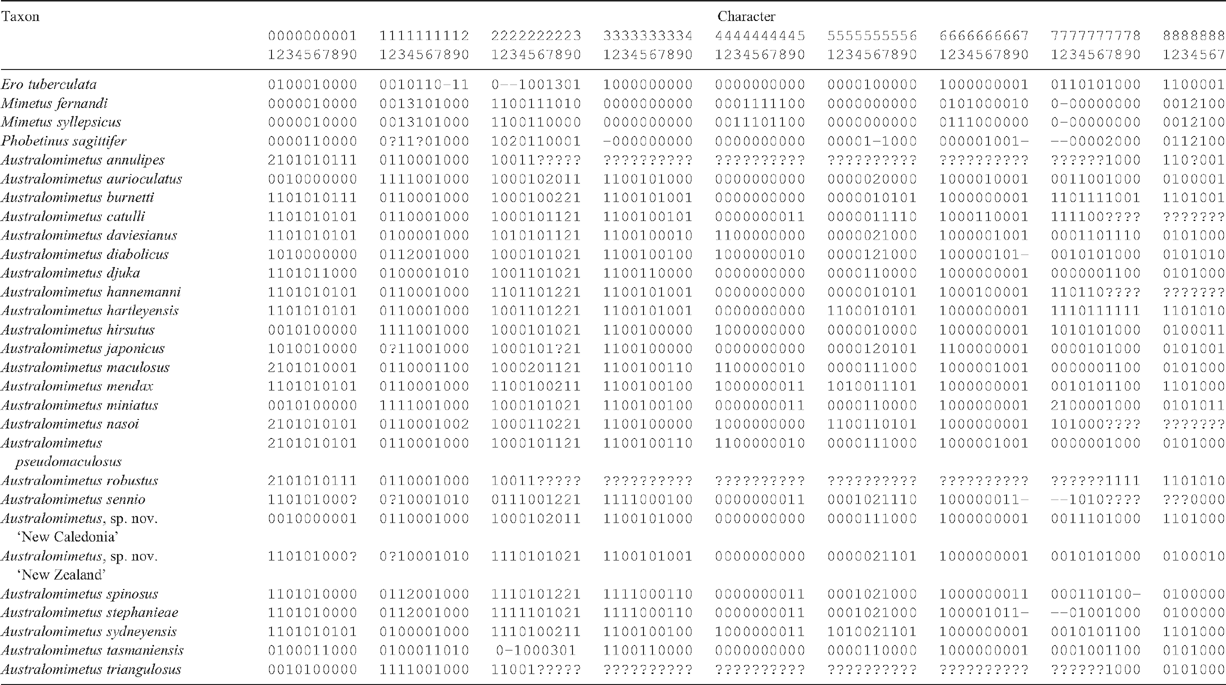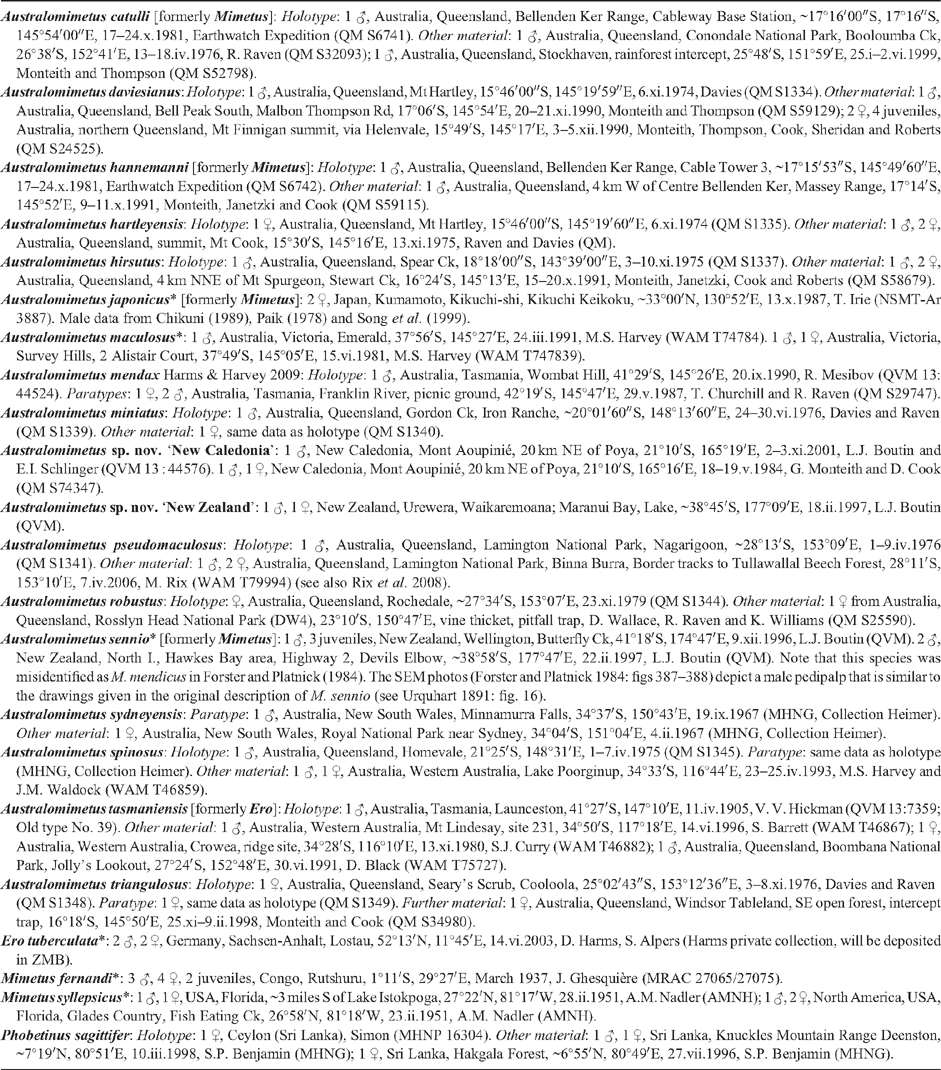Australian pirates: systematics and phylogeny of the Australasian pirate spiders (Araneae : Mimetidae), with a description of the Western Australian fauna
Danilo Harms A C D and Mark S. Harvey B CA Systematik und Evolution der Tiere, Fakultät für Biologie, Chemie und Pharmazie, Freie Universität Berlin, Königin-Luise-Straße 1–3, 14195 Berlin, Germany.
B Department of Terrestrial Zoology, Western Australian Museum, Locked Bag 49, Welshpool D.C., WA 6986, Australia and Division of Invertebrate Zoology, American Museum of Natural History, Central Park West at 49th Street, New York, NY 10024-5192, USA and California Academy of Sciences, Golden Gate Park, San Francisco, CA 94103-3009, USA.
C School of Animal Biology, University of Western Australia, Crawley, WA 6009, Australia.
D Corresponding author. Email: danilo.harms@museum.wa.gov.au
Invertebrate Systematics 23(3) 231-280 https://doi.org/10.1071/IS08015
Submitted: 3 April 2008 Accepted: 15 April 2009 Published: 21 July 2009
Abstract
Pirate spiders (Mimetidae) are well known for their specialised feeding ecology. They are vagrant araneophagic predators, enter the webs of their prey spiders and exhibit patterns of aggressive mimicry to overcome the web owner. The mimetid fauna of Australia and New Zealand currently consists of 26 species in the following three genera: Australomimetus Heimer, 1986 (18 species), Mimetus Hentz, 1832 (six species), and Ero C.L. Koch, 1836 (two species). The systematic position of the majority of Australasian mimetids was investigated through phylogenetic techniques utilising morphological character systems of 29 exemplar taxa and 87 characters, including the first examination of spinneret structure in species of Australomimetus. The results support an expanded concept for Australomimetus, which, apart from the introduced Ero aphana (Walckenaer, 1802), is found to contain the entire Australian and New Zealand mimetid fauna, also recorded from Asia. The following taxonomic changes are proposed: A. catulli (Heimer, 1989), comb. nov., A. hannemanni (Heimer, 1989), comb. nov., A. japonicus (Uyemura, 1938), comb. nov., A. mendicus (O. P. Cambridge, 1879), comb. nov. and A. sennio (Urquhart, 1891), comb. nov.; Ero luzoniensis Barrion & Litsinger, 1995 is synonymised with Ero aphana, and A. andreae Heimer, 1989 is synonymised with A. daviesianus Heimer, 1986; Mimetus tikaderi Gajbe, 1992 from India is excluded from Mimetidae, and referred to Liocranidae. The Western Australian mimetid fauna is described for the first time and comprises nine species of Australomimetus, including the following five new species: A. diabolicus, sp. nov., A. djuka, sp. nov., A. dunlopi, sp. nov., A. nasoi, sp. nov. and A. stephanieae, sp. nov. Several species-groups of Australomimetus are identified.
Additional keywords: Asia, Australomimetus, Ero, Mimetus, morphology, new species, New Zealand.
Acknowledgements
We are grateful to the following people for the loan of specimens that contributed to this study: Lisa J. Boutin (Queen Victoria Museum, Launceston), Josie Lynn, A. Catindig and K.L. Heong (International Rice Research Institute, Laguna), Paula Cushing (Denver Museum of Nature and Science, Denver), Jason Dunlop and Shahin Nawai (Museum für Naturkunde an der Humboldt-Universität zu Berlin), Hirotsugu Ono (National Science Museum, Tokyo), Norman I. Platnick (American Museum of Natural History, New York), Peter Schwendinger (Muséum d’Histoire Naturelle, Geneve) and Owen Seeman (Queensland Museum, Brisbane). Julianne Waldock (Western Australian Museum, Perth) is thanked for pre-sorting and collecting important specimens. Stephanie M. Alpers is thanked for guidance in fieldwork and for collecting specimens. The first author wishes to thank Barbara Baehr (Queensland Museum) for accommodation and hospitality during a visit to Brisbane. Thomas Bartolomaeus (Freie Universität Berlin) and Hannelore Hoch (Humboldt Universität zu Berlin) kindly supervised the activities of the first author and provided necessary documentation. Robert Raven (Queensland Museum), Jeremy Miller (National Natuurhistorisch Museum, Leiden) and an anonymous reviewer kindly commented on an early draft of the manuscript. Volker Framenau sacrificed a lot of his working time while introducing the first author to various computer programs and his indispensable support is deeply appreciated. The DAAD (German Academic Exchange Fund; Reference No. D/05/44196) partly financed the present study.
Blackledge T. A.,
Scharff N.,
Coddington J. A.,
Szüts T.,
Wenzel J. W.,
Hayashi C. Y., Agnarsson I.
(2009) Reconstructing web evolution and spider diversification in the molecular era. Proceedings of the National Academy of Sciences, USA 106, 5229–5234.
| Crossref | GoogleScholarGoogle Scholar |
CAS |
[verified March 2006].
Griswold C. E.,
Ramírez M.,
Coddington J. A., Platnick N. I.
(2005) Atlas of the phylogenetic data of entelegyne spiders (Araneae: Araneomorphae: Entelegynae) with comments on their phylogeny. Proceedings of the California Academy of Sciences 4th Series 56(Supplement II), 1–324.
[verified 29 April 2008].
Paik K. Y.
(1967) The Mimetidae (Araneae) of Korea. Kyungpook University Theses Collection 11, 185–196.
[verified 29 January 2009].
Platnick N. I., Shadab M. U.
(1993) A review of the pirate spiders (Araneae, Mimetidae) of Chile. American Museum Novitates 3074, 1–30.

Platnick N. I.,
Griswold C. E., Coddington J. A.
(1991) On missing entries in cladistic analysis. Cladistics 7, 337–343.
| Crossref | GoogleScholarGoogle Scholar |

Pleijel P.
(1995) On character coding for phylogenetic reconstruction. Cladistics 11, 309–315.
| Crossref | GoogleScholarGoogle Scholar |

Rainbow W. J.
(1904) Studies in Australian Araneidae No. 3. Records of the Australian Museum 5, 326–336.

Raven R. J.
(1991) A revision of the mygalomorph spider family Dipluridae in New Caledonia (Araneae). Mémoires du Muséum National d’Histoire Naturelle, Paris (A) 149, 87–117.

Raven R. J.
(1994) Mygalomorph spiders of the Barychelidae in Australia and the western Pacific. Memoirs of the Queensland Museum 35, 291–706.

Reimoser E.
(1919) Katalog der echten Spinnen (Araneae) des paläarktischen Gebietes. Abhandlungen der Zoologisch-Botanischen Gesellschaft in Wien 10, 1–280.

Rix M. G.
(2006) Systematics of the Australasian spider family Pararchaeidae (Arachnida: Araneae). Invertebrate Systematics 20, 203–254.
| Crossref | GoogleScholarGoogle Scholar |

Rix M. G.,
Harvey M. S., Roberts J. D.
(2008) Molecular phylogenetics of the spider family Micropholcommatidae (Arachnida: Araneae) using nuclear rRNA genes (18S and 28S). Molecular Phylogenetics and Evolution 46, 1031–1048.
| Crossref | GoogleScholarGoogle Scholar |
CAS |
PubMed |

Sanmartín I., Ronquist F.
(2004) Southern hemisphere biogeography inferred by event-based models: plant versus animal patters. Systematic Biology 53, 216–243.
| Crossref | GoogleScholarGoogle Scholar | PubMed |

Schütt K.
(2000) The limits of the Araneoidea (Arachnida: Araneae). Australian Journal of Zoology 48, 135–153.
| Crossref | GoogleScholarGoogle Scholar |

Shear W. A.
(1967) Expanding the palpi of male spiders. Brevoria of the Museum of Comparative Zoology 259, 1–27.

Shear W. A.
(1981) Structure of the male palpal organ in Mimetus, Ero and Gelanor (Araneoidea, Mimetidae). Bulletin of the American Museum of Natural History 170, 257–262.

Strong E. E., Lipscomb D.
(1999) Character coding and inapplicable data. Cladistics 15, 363–371.
| Crossref | GoogleScholarGoogle Scholar |

Tainaka A.,
Itoh Y.,
Yoshimura J., Asami T.
(2006) Geographical model of high species diversity. Population Ecology 48, 113–119.
| Crossref | GoogleScholarGoogle Scholar |

Thaler K.,
van Harten A., Knoflach B.
(2004) Pirate spiders of the genus Ero C.L. Koch from southern Europe, Yemen, and Ivory Coast, with two new species (Arachnida, Araneae, Mimetidae). Denisia 13, 359–368.

Unzicker J. D.
(1966) A review of the African Mimetidae (Arachnida: Araneae) with the description of a new species. Journal of the Kansas Entomological Society 39, 506–513.

Unzicker J. D.
(1977) The Mimetidae of St Helena Island (Arachnida: Araneae). Entomological News 88, 41–42.

Urquhart A. T.
(1891) On new species of Araneae. Transactions and Proceedings of the New Zealand Institute 23, 128–189.

Uyemura T.
(1938) Two new spiders from Wakayama Prefecture, Japan. Acta Arachnologica [In Japanese.] 3, 90–95.

Wang J. F.
(1990) Study on the spiders of the family Mimetidae from South China (Arachnida: Araneae). Acta Zootaxonomica Sinica 15, 36–47.

Wiens J. J.
(2006) Missing data and the design of phylogenetic analyses. Journal of Biomedical Informatics 39, 34–42.
| Crossref | GoogleScholarGoogle Scholar |
CAS |
PubMed |


|




